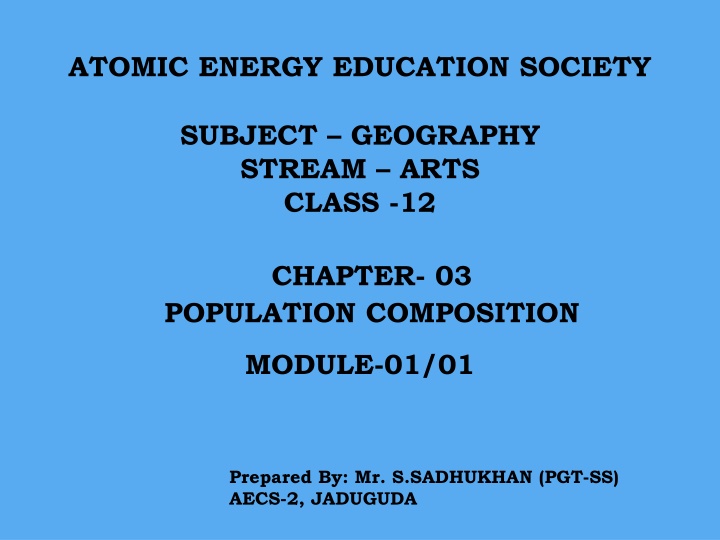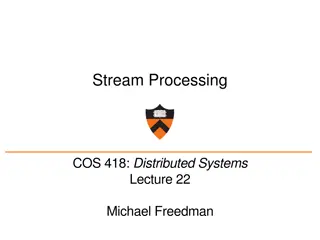STREAM
The study explores various aspects of population composition including sex ratio, age structure, age-sex pyramid, expanding, constant, and declining populations, and rural-urban composition. It covers factors influencing sex ratios, implications of age structures, and characteristics of different population pyramids.
Download Presentation

Please find below an Image/Link to download the presentation.
The content on the website is provided AS IS for your information and personal use only. It may not be sold, licensed, or shared on other websites without obtaining consent from the author.If you encounter any issues during the download, it is possible that the publisher has removed the file from their server.
You are allowed to download the files provided on this website for personal or commercial use, subject to the condition that they are used lawfully. All files are the property of their respective owners.
The content on the website is provided AS IS for your information and personal use only. It may not be sold, licensed, or shared on other websites without obtaining consent from the author.
E N D
Presentation Transcript
ATOMIC ENERGY EDUCATION SOCIETY SUBJECT GEOGRAPHY STREAM ARTS CLASS -12 CHAPTER- 03 POPULATION COMPOSITION MODULE-01/01 Prepared By: Mr. S.SADHUKHAN (PGT-SS) AECS-2, JADUGUDA
In some countries the sex ratio is unfavorable to women because (i) Female foeticide (ii) Female infanticide (iii) Domestic violence against women (iv) Lower socio-economic status of women The highest sex ratio in the world is recorded in Latvia where there are 85 males per 100 females. In Qatar there are 311 males per 100 females.
AGE STRUCTURE Age structure represents the number of people of different age groups. A large size of population in the age group of 15- 59 indicates a large working population. A greater proportion of population above 60 years represents an ageing population which requires more expenditure on health care facilities. High proportion of young population means that the region has a high birth rate and the population is youthful.
AGE-SEX PYRAMID The age-sex structure of a population refers to the number of females and males in different age groups.
Expanding Population This pyramid has larger population in lower age group due to high birth rate. Expanding population pyramid depict population that have a larger percentage of people in younger age group. Population with this shape usually has high fertility rates with lower life expectancies. The age-sex pyramid of Nigeria, Bangladesh and Mexico is triangular shaped with a wide base and is typical of less developed countries.
Constant Population This shows birth and death rates are almost equal. It is bell shaped and tapered towards the top.eg: Australia.
Declining Population This type of pyramid has a narrow base and tapered top showing low birth and death rates. The population growth in developed countries is usually zero or negative.eg: Japan
RURAL URBAN COMPOSITION Population is divided into two parts-rural and urban on the basis of the size and occupation of settlements. The rural population consists of small sized settlements scattered over the countryside. Urban population is one that lives in large size settlements i.e. towns and cities. Rural areas are those where people are engaged in primary activities and urban areas are those when majority of the working population is engaged in non- primary activities.
Literacy Proportion of literate population of a country is an indicator of its socio-economic development as it reveals the standard of living, social status of females, availability of educational facilities and policies of government. In India-literacy rate denotes the percentage of population above 7 years of age, who is able to read, write and have the ability to do arithmetic calculations with understanding.
Occupational Structure The working population takes place in various occupations ranging from agriculture, forestry, fishing, manufacturing, construction, commercial transport, services, communication and other unclassified services. Agriculture, forestry, fishing and mining are classified as primary activities, manufacturing as secondary, transport, communication and other services as tertiary and the jobs related to research and developing ideas as quaternary activities. The proportion of working population engaged in these four sectors is a good indicator of the levels of economic development of a nation. A developed economy with industries can accommodate more workers in the secondary, tertiary and quaternary sector. If the economy is in primitive stages, then the proportion of people engaged in primary activities would be high.























